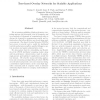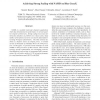IPPS
2006
IEEE
14 years 5 months ago
2006
IEEE
ClustalW is the most widely used tool for aligning multiple protein or nucleotide sequences. The alignment is achieved via three stages: pairwise alignment, guide tree generation ...
IPPS
2006
IEEE
14 years 5 months ago
2006
IEEE
In this paper we present a game theoretic approach to solve the static load balancing problem in a distributed system which consists of heterogeneous computers connected by a sing...
IPPS
2006
IEEE
14 years 5 months ago
2006
IEEE
In many distributed computing systems that are prone to either induced or spontaneous node failures, the number of available computing resources is dynamically changing in a rando...
IPPS
2006
IEEE
14 years 5 months ago
2006
IEEE
The increasing availability of high-performance computing systems with thousands, tens of thousands, and even hundreds of thousands of computational nodes is driving the demand fo...
IPPS
2006
IEEE
14 years 5 months ago
2006
IEEE
—Homology modeling requires an accurate alignment between a query sequence and its homologs with known three-dimensional (3D) information. Current structural modeling techniques ...
IPPS
2006
IEEE
14 years 5 months ago
2006
IEEE
IPPS
2006
IEEE
14 years 5 months ago
2006
IEEE
A self-stabilizing protocol is a brilliant framework for fault tolerance. It can recover from any number and any type of transient faults and eventually converge to its intended b...
IPPS
2006
IEEE
14 years 5 months ago
2006
IEEE
Modern FPGA platforms provide the hardware and software infrastructure for building a bus-based System on Chip (SoC) that meet the applications requirements. The designer can cust...
IPPS
2006
IEEE
14 years 5 months ago
2006
IEEE
NAMD is a scalable molecular dynamics application, which has demonstrated its performance on several parallel computer architectures. Strong scaling is necessary for molecular dyn...
IPPS
2006
IEEE
14 years 5 months ago
2006
IEEE
MPI provides a portable message passing interface for many parallel execution platforms but may lead to inefficiencies for some platforms and applications. In this article we sho...


